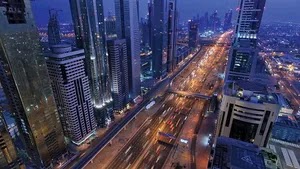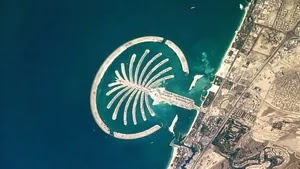Dubai - city in the United Arab Emirates
Dubai (City) | Geography, Creek, and History
Dubai is also the city and capital of the Emirate of Dubai, one of the richest of the seven emirates constituting the Federation of the United Arab Emirates, which was formed after independence from Great Britain in 1971. There are several theories about the origin of the name Dubai. One associates it with daba - a type of locust that infests the area - while the other believes that it refers to the market located near the city. Dubai has been compared to Singapore and Hong Kong in recent years and is often regarded as the premiere enterprise of the Middle East. Area 13.5 square miles (35 sq km). Pop. (2017 est.) 2,919,178.
Dubai, United Arab Emirates
Skyline of Dubai, United Arab Emirates at night.
character of the city
Dubai is a city of skyscrapers, ports and beaches, where the search for the sun is big business along with tourism. Due to its large migratory population, it seems like a Middle Eastern melting pot, and the environment is generally tolerant. Religious affiliations are not a major aspect of urban life. Islam is the majority religion, but churches and Hindu temples coexist with Dubai's mosques.
Dubai, United Arab Emirates: Sheikh Zayed Road
Sheikh Zayed Road, Dubai, United Arab Emirates at night.
Geoff Tompkinson/GTImage.com ( Britannica Publishing Partner )
Dubai is a relatively crime-free place where administrative efficiency and openness to business have encouraged astonishing growth. However, criticism of "Dubai's authoritarian government and the ruling elite" is not tolerated, and there remains an atmosphere of covert corruption.
landscape
Dubai's western region benefits from small stretches of sandy beaches, which have helped catalyze the city's tourism industry. Dubai's rulers sought to enhance the city's limited seafront, and in the absence of natural offshore islands, developers were encouraged to build vast man-made islands off the city's coast. The most famous of these is the Palm Jumeirah, which is shaped like a palm tree. Others include the "world" islands, a group of small islands that resemble a world map when viewed from above.
Palm Jumeirah
Photograph taken from Palm Jumeirah, Dubai, United Arab Emirates, International Space Station, 2005.
NASA
City site and layout
Dubai extends a natural gateway called Dubai Creek on the southern edge of the Persian Gulf. For more than a century, the region was the center of Dubai, due to the early city's dependence on fishing, pearl diving and maritime trade. Lining the creek are the oldest buildings in Dubai, most of which date back to the 1960s and rarely exceed two stories in height. In the Bastakiyah quarter on the western side of the bay, some of the older buildings have been restored, and many of these feature the distinctive wind tower design that was imported by Persian traders in the early 20th century.
Dubai, United Arab Emirates
Dubai, United Arab Emirates, as seen from the top of the Burj Khalifa.
Maher Najam (Britannica Publishing Partner)
The new city center is a series of skyscrapers on Sheikh Zayed Road. Notable among these are the Emirates Towers, built in the late 1990s and early 2000s and containing a hotel and government offices. Close to Sheikh Zayed Road are the Dubai International Financial Centre, located in a futuristic arch-shaped building, and the Burj Khalifa, which was the tallest building in the world at its official opening in 2010; It was named after the President of the United Arab Emirates and the Emir of Abu Dhabi, Khalifa Ibn Zayed Al Nahyan. To the west of the skyscrapers are many affluent suburbs, most of which have substantial villas. His perimeter is the Paraburj al-Arab, a massive sail-shaped tower that is home to a luxury hotel. Further west are the man-made marina and new clusters of skyscrapers surrounding several man-made lakes.
Burj Khalifa
Burj Khalifa, a mixed-use skyscraper in Dubai, United Arab Emirates.
© Photos/PhotosDubai: Burj Al Arab Hotel
Aerial view of Dubai with Burj Al-Arab Hotel in the foreground of Dubai, United Arab Emirates.
© Boarding1now/Dreamstime.com
Climate
Like most of the coast of the Persian Gulf, Dubai has a warm climate throughout the year. Humidity is high in the summer months and moderate the rest of the year. The coldest winter month is usually January, with a minimum temperature of about 15 °C (49 °F), while the warmest summer month is July, with temperatures above 40 °C (104 °F). .
People
Dubai's population has grown steadily over the past two centuries, growing from just a few thousand local residents to over two million. Much of the initial population growth was due to traders from neighboring countries relocating to Dubai's business-friendly 'environment'. The city's construction boom in the later 20th century led to a massive increase in the number of South Asian laborers and an influx of skilled migrants from around the world, who play an important role in Dubai's multi-sectoral economy. The number of expatriates in the city outweighs that of the native Emirati. With the exception of labourers, who are housed in work camps beyond the city limits, expatriates of various nationalities are spread across Dubai. Although Arabic is the official language, English is, in practice, the lingua franca.
The local population is predominantly Muslim, and the majority of the expatriate population is also Muslim, although there are significant Christian, Hindu and Sikh communities. Given the ruling family's tolerance of non-Muslims and the city's focus on business, the various communities coexist amicably, although there have been occasions when foreign residents have broken codes of decency or prohibitions on drug use.







Comments
Post a Comment